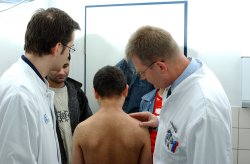Therapy of ichthyoses
|
|
|
|
The first has to with bathing and finding ways to re-moisturize the skin, symptomatic therapies, the second is related to retinoids...which have long lasting side affects. The first also dwells into a new type of therapy involving urea's being mixed with a carrier for topical applications. There really is no set procedure or documentation for assisting in the cure of Ichthyosis, only treatments to make life more comfortable if you live with Ichthyosis. (at least not that I can find)
The following is an exert taken from a clinic in Germany
Although we know for quite a few numbers of ichthyosis the molecular pathology a direct and causal therapy of these diseases is not possible so far. Therefore the therapy reflects the individual manifestations and the individual severity of the disease. This is called a symptom relieving or symptomatic therapy. As the skin is too dry, water and lipids have to be added and procedures to remove the scales from the skin have to be performed. The German experience is that bathing perhaps with an addition of salt and oil is very useful. These daily baths at the same time serve to cleanse the body and to remove remnants of ointments of scales and bacteria from the skin. Very frequently sponges and gloves are applied to rub the skin: in small children soft sponges in older persons harder sponges. This provides a good mechanical removal of scales. Ointments and creams for the external or topical ichthyosis therapy contain a so-called vehicle which contains oil in water in different concentrations. Examples for such vehicles are petrolatum, glycerine, lanolin-alcohols etc. Into these vehicles the pharmacist can incorporate different chemicals or agents which promote desquamation. These substances are urea, to some extent but with a general caveat salicylic acid, salt (NaCl), lactic acid and vitamin-A acid. In Germany we have also a very good experience with the ointment vehicle polyethylenglycol so-called charge 400. Similar to the experience in Sweden with propylenglycol this has a good keratolytic effect. Most often used is urea. Salicylic acid should not be used in small children or only for very small parts of the skin and for a short time as a whole body application can result in intoxications. The strongest scale remover is vitamin-A acid; however, this often results in skin irritation so that one has to be careful applying vitamin-A acid. A number of substances can also be combined with each other in order to have a stronger effect.
In Germany the following concentrations of keratolytic agents are now commonly used in the treatment for Ichthyosis. .
- Salicylic acid until 5 %,
- vitamin-A acid until 0.025 %,
- urea until 12 %,
- salt (NaCl) until 5 %,
- lactic acid until 5 %, sometimes up to 12 %,
- polyethylenglycol charge 300-400 for 20 to 30 %.
It is important to adapt the dosage in an individual manner. Therefore the thickness of the scaling has to be considered which can be different at different positions of the body. Moreover, the individual tolerability has to be considered which can differ between individuals and in particular between small children and adults quite a bit.
A systematic treatment using tablets with the substance acitretin (brand name for this drug is Neotigason in Germany) is also possible. These tablets belong to the group of retinoids which are substances that are related to vitamin-A. They regulate the development of the skin and its keratinization. They inhibit the formation of keratinocytes and normalize keratinization. Retinoids have a good effect in ichthyosis. Unfortunately retinoids also have a number of unwanted side effects. These include dryness of the lips (a side effect that is present in almost all patients with acitretin), dryness of the mucosa of the mouth and of the mucosa of the nose, dryness of the conjunctiva of the eyes and sometimes even inflammations of the conjunctiva of the eyes, a strong desquamation of the palms and soles resulting in an increased bruising of palms and soles, hair loss, nailwall inflammation (paronychia) and nail growth disturbances, increases of lipids in the serum. Possible are also effects on the bone and bone development. Women of child bearing age have to use a reliable contraception method as these drugs very often result in severe birth defects in the child. The dosage of the tablets needsto be adapted individually but usually is in the range of 0.5 mg per kg body weight per day. The indication for this drug has to be discussed with the doctor and the patient in detail. In the German self support group quite a few adult patients take these drugs. In children the general attitude usually is more conservative because of possible effects on bone development for example premature closure of the epiphyseal growth plates. Very many individuals tolerate the drug pretty well. Some individuals with ichthyosis take these drugs continually since about 1978 when they were first introduced in Germany.
A new form of systemic therapy making use of the principal of retinoids is in the pipeline of a pharmaceutical company. This drug will inhibit the catabolism of retinoic acid and thus increase endogeneous retinoic acid levels. It has already been tested in some patients with ichthyosis in Germany and the Netherlands, but is not yet available.
